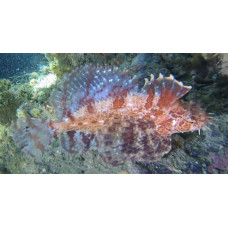Latin name
Blepsias bilobus
Other names
Blepsias bilobus
Identification
It has a deep, compressed body, all covered with spines. The snout is short, blunt, the interorbital space very broad, concave, equal to 1.5 of the eye diameter. There is a short occipital ridge. The mouth is wide, oblique, the maxilla extending to the vertical of the pupil. Teeth are small, sparsely distributed.
Features of fish fins
The first dorsal fin is smooth and rounded, not serrate. The second dorsal fin and anal fin are large and opposite each other. The dorsal fin has 8 or 9 spines and 21 or 22 soft rays, the anal fin has 18 to 20 soft rays. The pectoral fin has 15 to 17 rays and the small pelvic fin has 3 soft rays. The caudal fin is rounded.
Fish colouring
Upper body coloration is brown to olive green with indistinct spots on the dorsum, lighter on the ventral side. Fins have dark spots, except for the pectoral fin which has a dark band.
Distribution
North Pacific Ocean: from the northern Sea of Japan to the Bering Sea and northern British Columbia, Canada. Most abundant in the northwestern Pacific Ocean.
Habitat
It is a coastal bottom fish that inhabits depths from 0 to 250 m (0 to 820 ft), although it is often found off the bottom. It prefers temperate climates.
Size
The maximum published length is 25 cm (9.8 inches).
Behavior
They are found near the shore, often well above the bottom. They are poor swimmers and do not migrate. They are usually found as individuals and do not form schools.
Food and feeding habits
Predator, feeds on fish and invertebrates.
Reproduction
Caviar is large, with a thick shell, sticky.
Fishing
They have no commercial significance.
Relationship with a person
Not to be eaten.
| Classification | |
| Phylum | Chordata |
| Class | Actinopterygii |
| Squad | Scorpaeniformes |
| Family | Agonidae |
| Genus | Blepsias |
| Species | B. bilobus |
| Features | |
| Conservation status | Least Concern |
| Habitat | Bottom |
| Life span, years | No information |
| Maximum body weight, kg | No information |
| Maximum length, cm | 25 |
| Sailing speed, m/s | No information |
| Threat to people | Not edible |
| Way of eating | Predator |
Crested sculpin
Tags: crested sculpin


